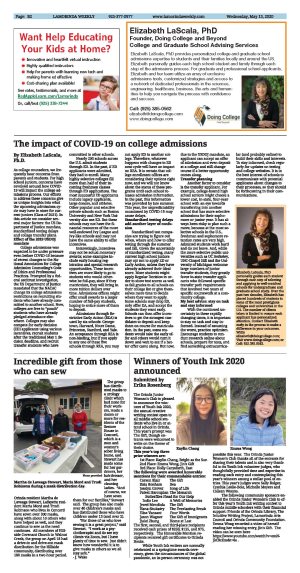| | Published May 13th, 2020
| The impact of COVID-19 on college admissions
| | | By Elizabeth LaScala, Ph.D. |  | | Elizabeth LaScala, PhD personally guides each student through each step of selecting and applying to well-matched schools for undergraduate and graduate school study. Over the past two decades, Elizabeth has placed hundreds of students in some of the most prestigious colleges and universities in the U.S. The number of clients taken is limited to ensure each applicant has personalized attention. Contact Elizabeth early in the process to make a difference in your outcomes. Write elizabeth@doingcollege.com; Visit www.doingcollege.com; or Call: 925.385.0562. |
As college counselors, we frequently hear concerns from parents and students. For high school juniors, concerns have revolved around how COVID-19 will impact the college admissions process. Our efforts to address these concerns give us unique insights into what the upcoming admissions cycle may have in store for current juniors (Class of 2021). In this article we consider several major factors: the US Department of Justice mandate, standardized testing delays and college transfer plans.
 Effect of the 2019 USDOJ mandate
Effect of the 2019 USDOJ mandate
 College admissions was expected to be under pressure even before COVID-19 because of recent changes to the National Association for College Admission Counseling's Code of Ethics and Professional Practices. Prompted by a federal antitrust investigation, the US Department of Justice mandated that the NACAC change its college admissions restrictions on recruiting students who have already committed to another school. Now, colleges are free to "poach" students who have already pledged attendance elsewhere. Colleges may also compete for early decision (ED) applicants using various incentives, recruit students after the traditional May 1 decision deadline, and recruit transfer students who have committed to other schools.
College admissions was expected to be under pressure even before COVID-19 because of recent changes to the National Association for College Admission Counseling's Code of Ethics and Professional Practices. Prompted by a federal antitrust investigation, the US Department of Justice mandated that the NACAC change its college admissions restrictions on recruiting students who have already committed to another school. Now, colleges are free to "poach" students who have already pledged attendance elsewhere. Colleges may also compete for early decision (ED) applicants using various incentives, recruit students after the traditional May 1 decision deadline, and recruit transfer students who have committed to other schools.
 Nearly 200 schools across the U.S. admit students through ED. In the past, if ED applicants were admitted, they had to enroll. Many highly selective colleges fill more than half of their incoming freshmen classes through ED applications. The most successful ED applicants include legacy applicants, large donors, and athletes. Other popular and selective private schools such as Boston University and New York University also use ED. But these schools may not have the financial resources of the more well-endowed Ivy League and Ivy-like schools and may not have the same ability to offer incentives.
Nearly 200 schools across the U.S. admit students through ED. In the past, if ED applicants were admitted, they had to enroll. Many highly selective colleges fill more than half of their incoming freshmen classes through ED applications. The most successful ED applicants include legacy applicants, large donors, and athletes. Other popular and selective private schools such as Boston University and New York University also use ED. But these schools may not have the financial resources of the more well-endowed Ivy League and Ivy-like schools and may not have the same ability to offer incentives.
 Interestingly, incentives may not be actual monetary awards; some examples include early housing reg-istration and special research opportunities. These incentives are more likely to go to students who would otherwise be full-pay, since if they matriculate, they will bring in more tuition dollars over time. Admissions offices might offer small awards to a larger number of full-pay students, hoping to entice more of them to deposit.
Interestingly, incentives may not be actual monetary awards; some examples include early housing reg-istration and special research opportunities. These incentives are more likely to go to students who would otherwise be full-pay, since if they matriculate, they will bring in more tuition dollars over time. Admissions offices might offer small awards to a larger number of full-pay students, hoping to entice more of them to deposit.
 Admissions through Restrictive Early Action (REA) is used by six schools: Georgetown, Harvard, Notre Dame, Princeton, Stanford, and Yale. An acceptance through REA is non-binding, but if you apply to any one of these five schools through REA, you may not apply ED to another college. Therefore, whatever happens with changes to ED next cycle will have an impact on REA. It is certain that college enrollment offices are considering their options right now, and we will not know about the status of these programs until each school releases admission information. In the past, this information was provided by late summer. This year, the unpredictability occasioned by COVID-19 may cause delays.
Admissions through Restrictive Early Action (REA) is used by six schools: Georgetown, Harvard, Notre Dame, Princeton, Stanford, and Yale. An acceptance through REA is non-binding, but if you apply to any one of these five schools through REA, you may not apply ED to another college. Therefore, whatever happens with changes to ED next cycle will have an impact on REA. It is certain that college enrollment offices are considering their options right now, and we will not know about the status of these programs until each school releases admission information. In the past, this information was provided by late summer. This year, the unpredictability occasioned by COVID-19 may cause delays.
 Standardized testing delays add another layer of confusion
Standardized testing delays add another layer of confusion
 Standardized test companies are trying to figure out when, where and how to offer testing through the summer and fall. Given the uncertainly of standardized testing, many current high school juniors may opt not to apply ED or Early Action, unless they have already achieved their ideal score. More students might apply Regular Decision in order to show test scores as well as fall grades to all schools on their college list or give themselves more time to decide where they want to apply. Some schools may drop ED, only offer EA, and accept the students they want early. Schools can then offer incentives to get the strongest candidates to deposit and keep them on course for matriculation. In the past, some students would take the early offer and others would turn it down and wait to see if a better offer came along. But now, due to the USDOJ mandate, an applicant can accept an offer of admission and even deposit at a college and still change course if a better opportunity comes along.
Standardized test companies are trying to figure out when, where and how to offer testing through the summer and fall. Given the uncertainly of standardized testing, many current high school juniors may opt not to apply ED or Early Action, unless they have already achieved their ideal score. More students might apply Regular Decision in order to show test scores as well as fall grades to all schools on their college list or give themselves more time to decide where they want to apply. Some schools may drop ED, only offer EA, and accept the students they want early. Schools can then offer incentives to get the strongest candidates to deposit and keep them on course for matriculation. In the past, some students would take the early offer and others would turn it down and wait to see if a better offer came along. But now, due to the USDOJ mandate, an applicant can accept an offer of admission and even deposit at a college and still change course if a better opportunity comes along.
 Transfer planning
Transfer planning
 Another factor to consider is the transfer applicant. For example, college-bound high school seniors might choose a lower cost, in-state, four-year school with an eye towards transferring into another school that has more selective admissions for their sophomore or junior year. It has always been risky to plan such a move, because at the most selective schools in the U.S., freshman and sophomore retention rates are very high. Admitted students work hard and do not leave. And, while the more selective public universities such as UC Berkeley, UNC-Chapel Hill and the University of Michigan welcome large numbers of junior transfer students, they greatly favor in-state transfer applicants who followed specific transfer path requirements that involved two years of specific coursework at a community college.
Another factor to consider is the transfer applicant. For example, college-bound high school seniors might choose a lower cost, in-state, four-year school with an eye towards transferring into another school that has more selective admissions for their sophomore or junior year. It has always been risky to plan such a move, because at the most selective schools in the U.S., freshman and sophomore retention rates are very high. Admitted students work hard and do not leave. And, while the more selective public universities such as UC Berkeley, UNC-Chapel Hill and the University of Michigan welcome large numbers of junior transfer students, they greatly favor in-state transfer applicants who followed specific transfer path requirements that involved two years of specific coursework at a community college.
 My best advice: stay on task and stay informed
My best advice: stay on task and stay informed
 With the continued uncertainty in these rapidly changing times, it is important to stay on task and stay informed. Instead of assuming the worst, practice optimism. Encourage students to conduct research online about schools, prepare for tests, and find something extracurricular (and probably online) to build their skills and interests. To stay informed, check regularly for updates on testing and college websites. It is in the best interest of schools to communicate with potential applicants about changes to their processes, so they should be forthcoming in their communications.
With the continued uncertainty in these rapidly changing times, it is important to stay on task and stay informed. Instead of assuming the worst, practice optimism. Encourage students to conduct research online about schools, prepare for tests, and find something extracurricular (and probably online) to build their skills and interests. To stay informed, check regularly for updates on testing and college websites. It is in the best interest of schools to communicate with potential applicants about changes to their processes, so they should be forthcoming in their communications. |
| | | | | | | | | | | | |



